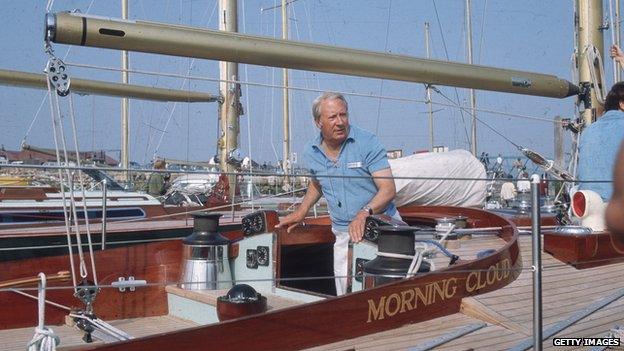Sweets and football: How the UK celebrated joining Europe
- Published
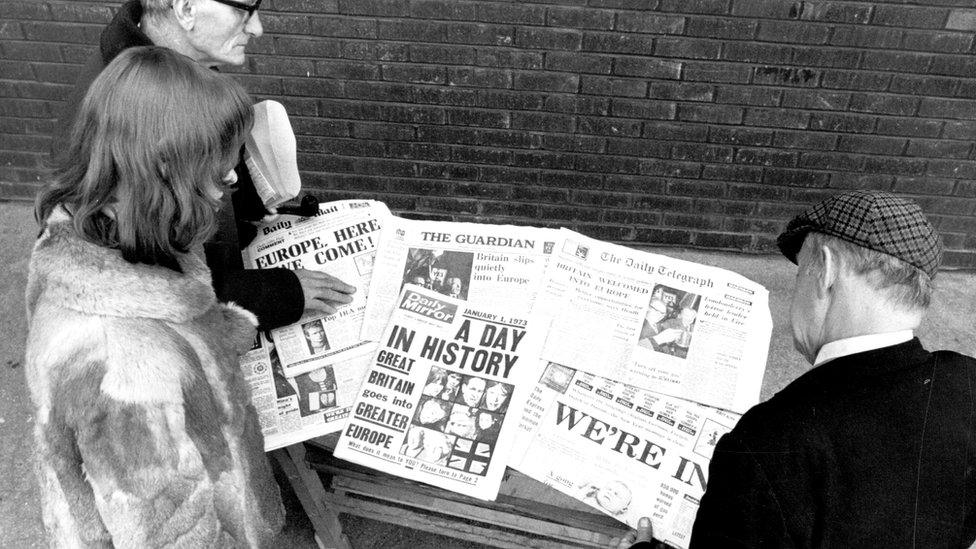
A light show in Downing Street and a new 50p coin will be among official events marking Brexit on Friday.
Despite some accusations of triumphalism, the tone marks a more muted contrast with British entry into the then European Economic Community (EEC) in 1973.
A new 50p was also minted back then - featuring nine interlocking hands, external to reflect the newly-expanded membership of the club.
But Conservative Prime Minister Edward Heath went further, and organised 11 days of government-subsidised cultural events.
Beginning three days after entry on 1 January, the "Fanfare for Europe" featured hundreds of musical, artistic, and sporting events.
As with Brexit in 2020, the occasion was not immune from political wrangling.
Mr Heath, a Europhile who had long dreamed of witnessing British entry into the EEC, known as the Common Market, took an active role in certain events.
He attended a special gala at the Royal Opera House, and personally presented prizes to British and EEC children who won free holidays in an essay competition.
He also brought down the starting flag on a rally of dozens of vintage cars from London to Brussels.
The decision to put himself at the centre of events did not come without risks, however, as some events saw protests from anti-market protestors.
In fact, the prime minister was stink-bombed as he arrived for the gala in Covent Garden alongside the Queen.

Edward Heath met folk group Steeleye Span before they played at the Royal Albert Hall
In total, seven government departments and two specially-created temporary committees were involved in devising the programme for the Fanfare.
Crossbench peer and Arts Council chairman Lord Goodman led a committee responsible for cultural events - while a second committee, chaired by the Conservative peer Lord Mancroft, took the lead in other fields.
Cultural events dominated the schedule, with 25 art exhibitions on European themes arranged, as well as scores of concerts.
The Berlin Philharmonic were brought over for special concert, whilst groups such as the Kinks, Steeleye Span and Slade all had gigs.
Mona Lisa denied
At the Victoria and Albert Museum, an exhibition was put together featuring artwork loaned especially by each of the six existing EEC members.
Denmark sent two Bronze Age wind instruments, while the Italian donation, a bust of Brutus by Michelangelo, was described in the programme as a "highly expressive tribute to the fight against tyranny".
Meanwhile France, which had twice vetoed British entry into the EEC in the 1960s, sent a 17th Century depiction of card cheating by painter Georges de la Tour.
However an attempt to bring the Mona Lisa to London reportedly failed when a request to send the Rosetta Stone to the Louvre in exchange was turned down.

Formula One's Stirling Moss at the vintage car rally, organised by Lord Montagu of Beaulieu (R)
Among the headline events was a special football match at Wembley, which pitted players from the six existing EEC countries against a team composed of players from the UK, Ireland and Denmark, who joined together in 1973.
The 'Three', selected by England World Cup-winning manager Sir Alf Ramsey, ran out 2-0 victors with goals from Danish international Henning Jensen and Coventry City striker Colin Stein.
Among the British stars who featured were England's Bobby Moore and Bobby Charlton, and Scottish international Peter Lorimer.
German international Franz Beckenbauer also took part, although he was taken off at half-time.
Despite the star appearances, however, ticket sales were slow and only 36,500 fans turned up, not much more than a third of Wembley's capacity at that time.
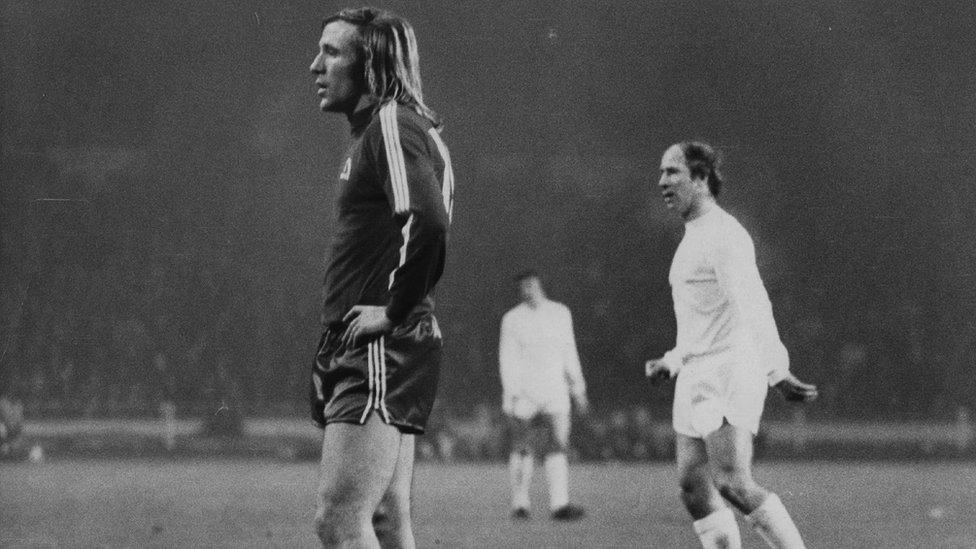
England's Bobby Charlton (R) captained The Three in a match against the EEC
Lack of enthusiasm did not stop there, with Lord Mancroft admitting to the Times three months before events began that some councils had refused to take part.
"But we found a much greater number, who, while not being very enthusiastic, have accepted that British entry is going to happen and are prepared to join us and do their best," he added.
Taxpayer support of £350,000 - around £4.2m in today's terms - also proved contentious, despite protestations from Lord Goodman to MPs scrutinising expenditure that it was a "trivial sum of money for this festival".
Labour leader Harold Wilson - who had opposed the Conservative deal taking the UK into the EEC - called government subsidies "an outrage".
He suggested that instead of the festivities, it would have been more appropriate to give all British workers a bank holiday.
Apart from in Scotland, the UK was the only EEC country not to offer its workers time off on New Year's Day at the time it joined - but the first day of the year had long been marked by widespread absenteeism in certain sectors.
Perhaps recognising the inevitable, Ford and British Leyland were among the firms that voluntarily gave staff that day off in 1973.
New Year's Day became a UK-wide bank holiday in 1974.
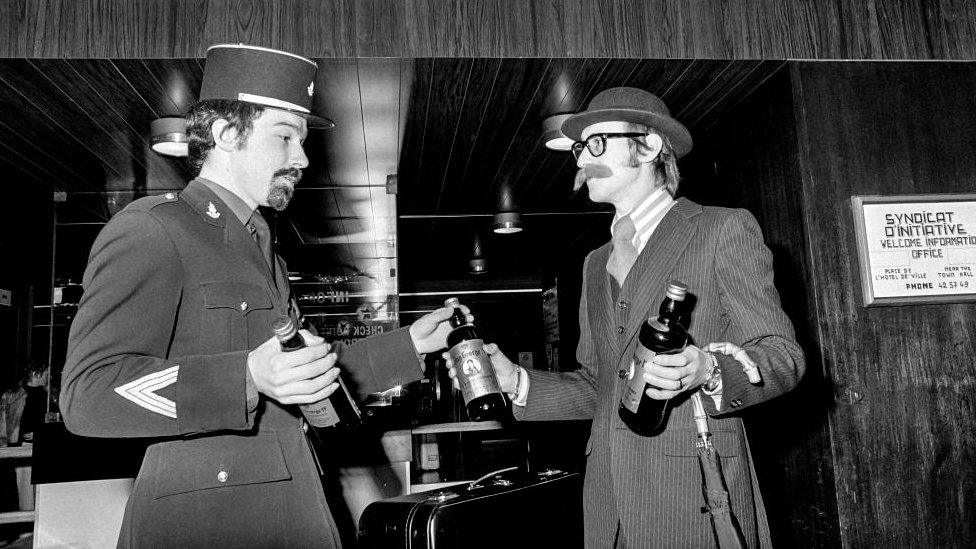
A British man offering a whisky bottle to a French customs officer on entry night
Edward Heath also had to fend off accusations that the Fanfare was a propaganda exercise, dominated by highbrow events concentrated in London.
Things were hardly helped by the timing of Britain's EEC entry, which took place in the midst of a government-imposed pay freeze to control inflation.
Jim Callaghan, a future Labour PM then serving as the party's shadow foreign secretary, made the link when the issue was debated in the Commons.
"It might be thought that because the government cannot give the people bread, they are giving them circuses," he quipped.
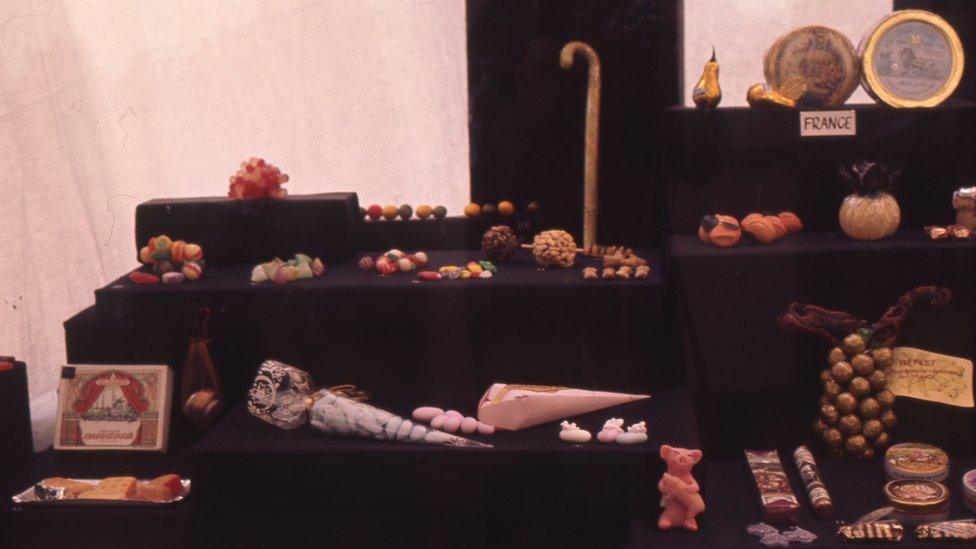
An exhibition in east London featured European sweets as a form of popular art
Despite the differences with today's circumstances, Brexit has bridged the decades with the Fanfare in one respect - with the revival of one element of the EEC festivities that went rather awry back in 1973.
A 1973 exhibition at the Whitechapel Gallery in east London, entitled "Sweets", was brought to an abrupt end on its final day when the display of European confectionary was devoured by schoolchildren who had overwhelmed a guard.
The exhibition was recreated, external to coincide with the expected date of the UK's exit in March last year, alongside a specially-commissioned film from German artist Ulla von Brandenburg.
Ahead of its opening, she told the gallery the exhibition offered the chance to reflect on both the political and culinary tastes of the two periods.
"What is funny is that a lot of sweets didn't change," she said at the time.
"The world has changed a lot since 1973, but not the sweets."
- Published26 January 2020

- Published4 October 2017
